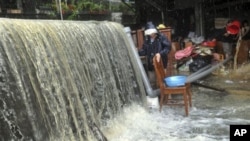Two new studies show the coastal megacities of Asia could be facing some big problems.They warn that changes in the climate mean many of these cities face massive flooding in the future.
One of the studies from the World Bank, the Asian Development Bank and the Japan International Cooperation Agency examined Bangkok, Ho Chi Minh City and Manila, all with populations close to or over 10 million.
A second study comes in the form of a research paper from the East West Center in Hawaii. The paper's author is Dr. Roland Fuchs.
What does your research show about the problems facing the world’s coastal cities?
Of the 10 cities at greatest risk of coastal flooding, typhoon and storm damage, 9 of the 10 were in Asia. There are many reasons for that, but the biggest reason is that there are so many cities clustered along the coast. The coasts of Asia have a great attraction economically and aesthetically but that could be a fatal attraction. There have been many lives lost over the last century because of flooding: over a million around the Bay of Bengal alone.
What are some of the cities that are most at risk?
Any of the major cities located on the deltas of Asia. They would include cities such as Ho Chi Minh City, Bangkok, Jakarta, Manila, Mumbai, and Kolkata. All of these cities are at very high future risk because not only is the temperature going up, but sea levels are rising, rising at a faster rate than previously estimated. You also have sinking of these deltas. These cities are often located on deltas on which the land is subsiding and often that subsidence rate is greater than that of the sea level rise. So the combination makes them highly vulnerable to future storms, coastal storms, typhoons and intense rainfall events.
What can realistically be done?
The first thing is to get an accurate risk and vulnerability assessment taking into account not only the past extreme events but also greater events in the future. I think much more spatial planning has to be done. I don’t think these cities have faced up to the fact that they’ll probably have to relocate many of their activities and their population over time and simply accommodate to the fact that there will be higher sea levels and more vulnerable areas along the coast. There need to be some improvements in drainage, dykes and dams and that sort of thing. You need to have better training for many of these urban managers and planners. The fact is that there is no background in climate change or climate change risk and risk reduction methods in the planning curricula for Southeast Asia. I’ve just come back from a conference in Indonesia, and while there is a growing awareness that flooding is becoming an increasing problem, they still don’t have any programs in place to deal with that issue.
Three Questions: Asian Coastal Cities at Risk
- By Ira Mellman









